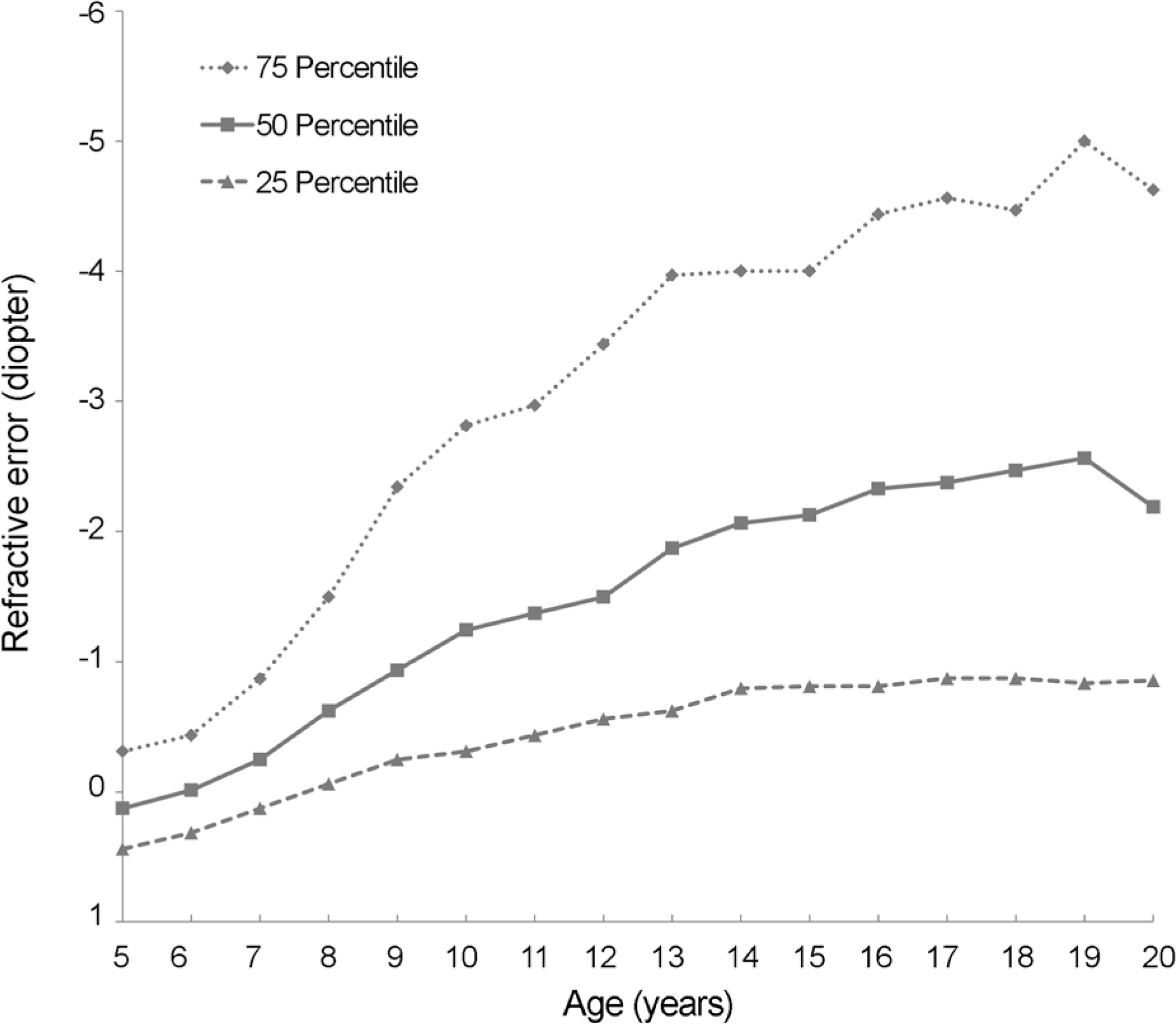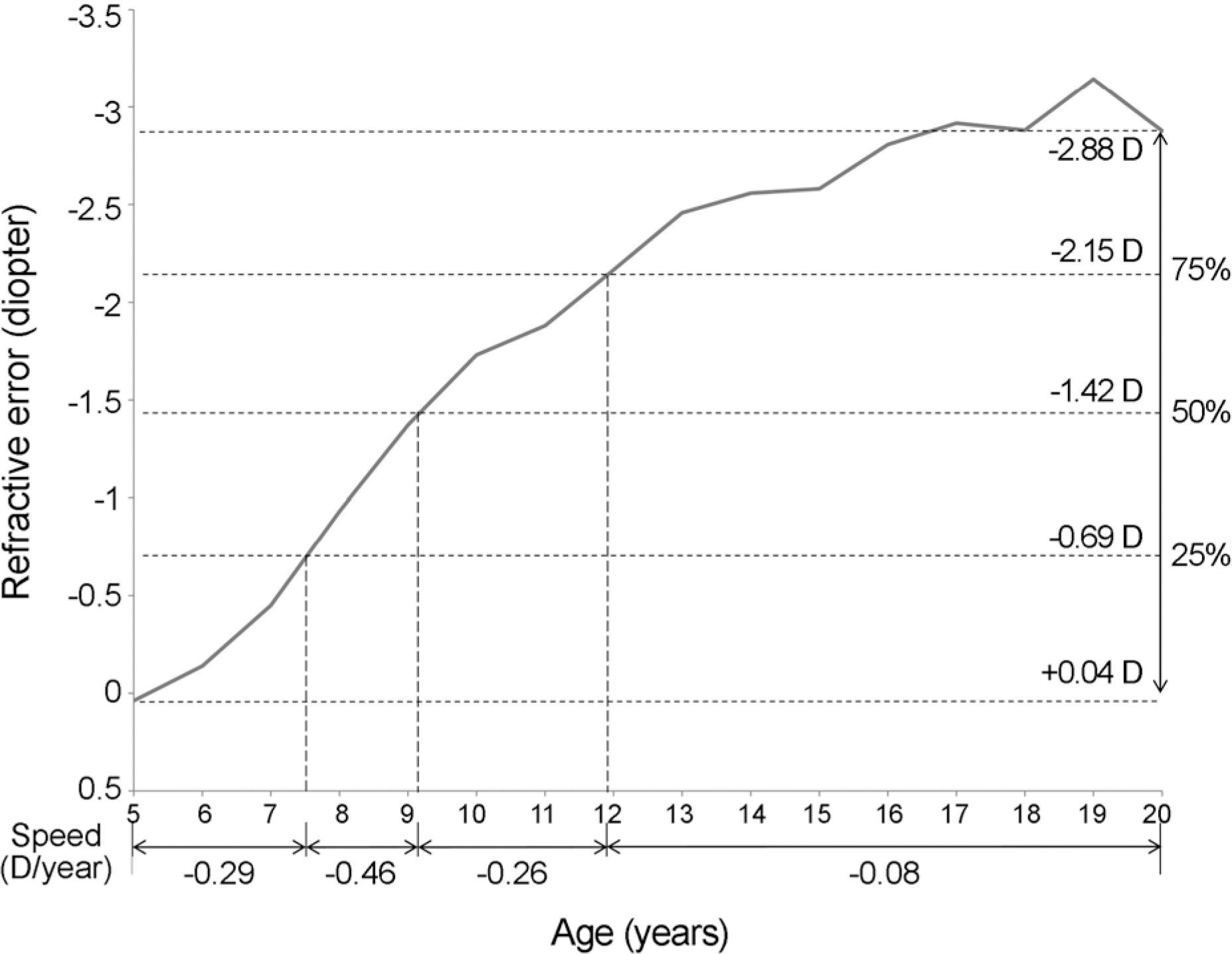Abstract
Purpose
To investigate the degree, distribution, and change in refractive error in the pediatric population 5 to 20 years of age.
Methods
We collected data from 7,695 subjects aged 5 to 20 years who participated in the Korean National Health and Nutrition Examination Survey from 2008 to 2012. Non-cycloplegic refractive error was measured using an autorefractor. Mean spherical equivalent calculated from the measured refractive error data in both eyes was used. The subjects were categorized into mild, moderate, or high refractive abnormality or emmetropia according to the degree of refractive error. The degree and distribution of refractive error in all subjects and age-matched subjects were analyzed. The change in refractive error was analyzed according to age.
Results
Mean refractive error of the study subjects was −1.82 diopters. As subject age increased, myopia increased from +0.04 diopters at 5 years of age to −2.88 diopters at 20 years of age. Myopia was observed in 66.2% of subjects and accounted for only 18.5% of the 5-year-old subjects, but increased to 84.3% in the 20-year-old subjects. The rate among all study subjects was −0.19 diopters per year. The greatest myopic progression rate (−0.46 diopters per year) among all age groups was in subjects 7 to 9 years of age. Myopic progression continued until 16 years of age.
Go to : 
References
1. Holden BA, Fricke TR, Wilson DA, et al. Global prevalence of abdominal and high myopia and temporal trends from 2000 through 2050. Ophthalmology. 2016; 123:1036–42.
2. Harper AR, Summers JA. The dynamic sclera: extracellular matrix remodeling in normal ocular growth and myopia development. Exp Eye Res. 2015; 133:100–11.

3. Wong TY, Ferreira A, Hughes R, et al. Epidemiology and disease burden of pathologic myopia and myopic choroidal neovascularization: an evidence-based systematic review. Am J Ophthalmol. 2014; 157:9–25.e12.

4. Goss DA, Cox VD, Herrin-Lawson GA, et al. Refractive error, abdominal length, and height as a function of age in young myopes. Optom Vis Sci. 1990; 67:332–8.
5. Smith MJ, Walline JJ. Controlling myopia progression in children and adolescents. Adolesc Health Med Ther. 2015; 6:133–40.
6. Chia A, Lu QS, Tan D. Five-year clinical trial on atropine for the treatment of myopia 2: myopia control with atropine 0.01% eyedrops. Ophthalmology. 2016; 123:391–9.
7. Kim SH, Kim SM. Survey on causative factors responsible for the school myopia. J Korean Ophthalmol Soc. 1977; 18:45–9.
8. Lee MJ, Lee YH, Shyn KH. The progression of myopia with age. J Korean Ophthalmol Soc. 1987; 28:151–5.
9. Kim SY, Min BM. Myopic progression according to the age of onset in childhoods. J Korean Ophthalmol Soc. 1998; 39:721–7.
10. Choi KW, Koo BS, Lee HY. Preschool vision screening in Korea: results in 2003. J Korean Ophthalmol Soc. 2006; 47:112–20.
11. Choi YH, Choi YY. The difference comparison according to child refractive method and effect of life style on myopia. J Korean Ophthalmol Soc. 2005; 46:1841–7.
12. Han ER, Kang JE, Jun RM, Choi KR. Changes of refractive errors and optometric values in fourth graders at an urban elementary school in Korea. J Korean Ophthalmol Soc. 2007; 48:1119–25.

13. Kim EC, Morgan IG, Kakizaki H, et al. Prevalence and risk factors for refractive errors: Korean National Health and Nutrition Examination Survey 2008–2011. PLoS One. 2013; 8:e80361.

14. You QS, Wu LJ, Duan JL, et al. Prevalence of myopia in school children in greater Beijing: the Beijing Childhood Eye Study. Acta Ophthalmol. 2014; 92:e398–406.

15. Yip VC, Pan CW, Lin XY, et al. The relationship between growth spurts and myopia in Singapore children. Invest Ophthalmol Vis Sci. 2012; 53:7961–6.

16. Jung JW, Kim YE, Paik HJ. Clinical comparison of autorefractor versus retinoscopic refraction in children according to the age. J Korean Ophthalmol Soc. 2005; 46:1931–5.
Go to : 
 | Figure 1.The change of refractive error according to the age of subjects (Y-axis inverted). Each line depicted refractive error of a subject at 25 percentile, 50 percentile and 75 percentile. |
 | Figure 2.Mean refractive error according to the age of subjects (Y-axis inverted). The total difference of the refractive error between 5 year-old subjects and 20 year-old subjects was 2.92 diopters (D). The 25% of the difference occurred from 5 to 7.5 years, 50% to 9.1 years, and 75% to 11.9 years. Myopic progression was the fastest between 7.5 and 9.1 years of age. |




 PDF
PDF ePub
ePub Citation
Citation Print
Print



 XML Download
XML Download